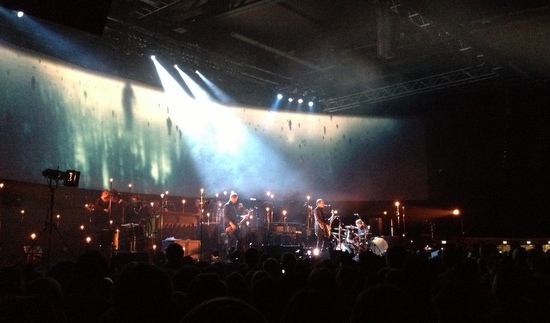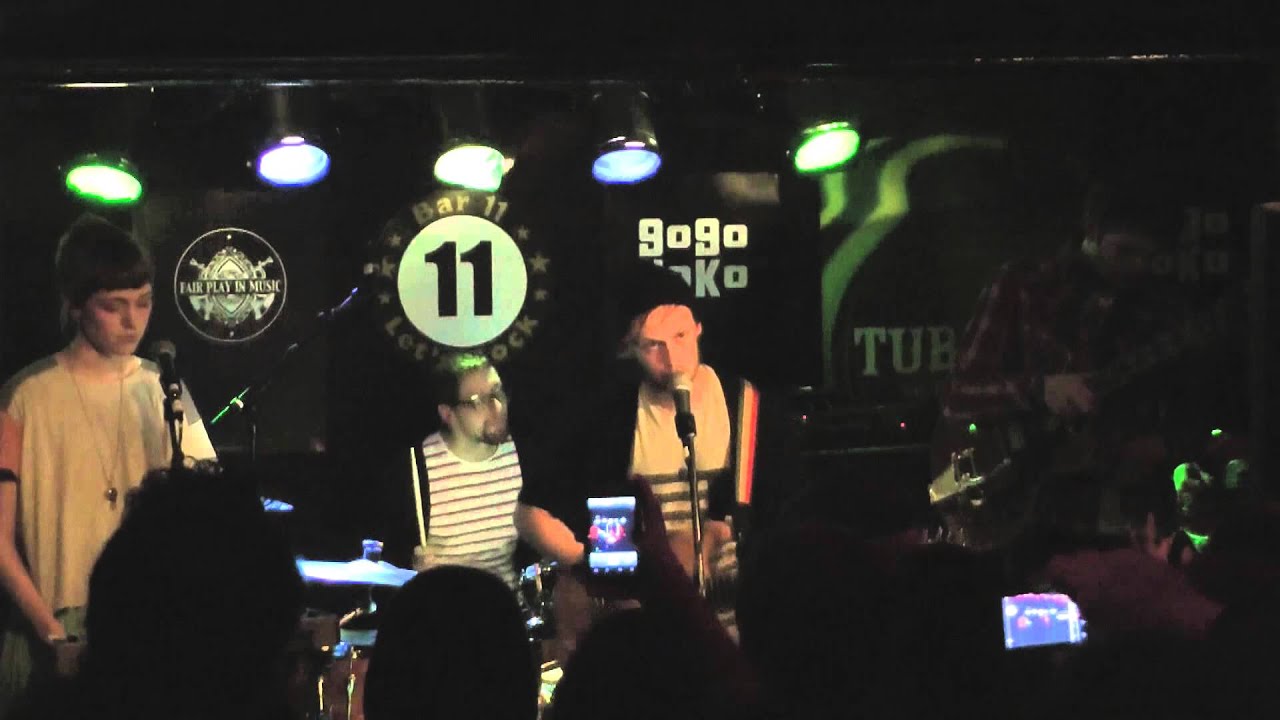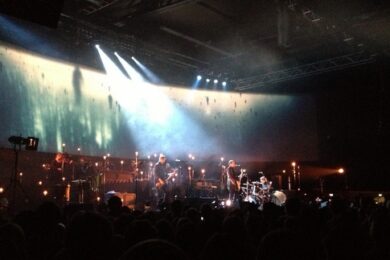Icelandic November is a bit like the Mayans imagined 2012 might be.
Forget anything you think you know about being cold. I don’t care if you’ve been camping in the Scottish midwinter, I don’t care if you forgot your coat and got hit by a January hailstorm on Hampstead Heath, or if you made the common error of going to Olso’s By:Larm festival wearing Converse instead of Caterpillar. That’s nothing. Let’s call that "a bit nippy". It’s a walk in a sunny park compared to the biting Icelandic winter, which descended forcefully over Airwaves 2012 as if to redress the balance for the rare and glorious summer the country’s 300k inhabitants enjoyed earlier in the year.
Airwaves slid farther into the "tourist off-peak" season in 2012, with the two-week difference that placed the festival in early November rumoured to have come at the behest of the festival’s sponsor, IcelandAir. The new calendar slot was, unfortunately for performers and festival goers alike, beset by fierce weather problems. Some of it was plain bad luck, with Hurricane Sandy putting paid to performances by key headline acts Swans and Poliça in the ensuing travel chaos. Other stuff, like long queues for key venues in sub-zero temperatures, seemed more forseeable. Thankfully a press wristband allowed me preferential entry to the beautiful array of small venues the city has to offer, or I’d have missed out entirely on crammed hotspots like the lakeside Iðno concert hall and the Kaldalón theatre.
On Saturday morning, the edge of the hurricane hit Reykjavík, with a flashpoint occurring as I walked down the city’s main street, Laugavegur. A hapless Chinese guy was blown clean off his feet next to me, and an Icelandic family held on to a bollard for dear life as the wind tore off their hats and cast them into the sky like leaves. I was stopped in my tracks by a wall of wind, and scrambled sideways into a nearby doorway where six or seven people were trapped for twenty minutes. When we were able to leave, the street had been closed by the city´s emergency response unit – the wind was tearing the metal roof from a building, and a crane being brought in to hold it on.
"Talking about the weather" is often thought of as a British national obsession, but we have nothing on Icelanders. In the face of the dangerous natural ferocity that this hardy lot have to deal with, their heightened interest in meteorology seems more like common sense than conversational nicety.
Cool kids, they belong together.
In any given country, the fault lines between popular and subcultural music are different. In Norway, for example, you might see incongruously clean-cut blonde ‘n’ blue audience members taking in a black metal show with an open-minded ease that would seem inconceivable in England.
Here in Iceland, that kind of musical curiosity seems to be the default setting. As such, bands often share members – an indie-pop band might have a drummer you’d see playing the next night in a hardcore band. One in-demand Icelandic drummer (Magnus Eliassen) played seven shows in one night, apparently discovering muscles he didn’t know existed in the process.
As such, both crowds and bands are mixed in a way that seems unusual and positive. There’s a feeling that people are in it together, whatever "it" happens to be at any given moment. When big US bands cancelled their shows, people were momentarily disappointed, but shrugged their shoulders and got on with things, with Icelandic pop renaissance man Mugison stepping into the breach to fill the Swans slot with characteristic big-hearted gusto. In England, there’d have been bleating and carping and refund demands till the cows had come home and gone out again, but in Iceland, people just got on with the party.
It is possible for a mournful Appalachian folk singer to start said party with his banjo.
American folk singer Sam Amidon is pretty much an honorary Icelander. For a start, he’s on the Bedroom Community label, one of the top independent record labels in the world today, and home to artists of genre-bending imagination, musical scope and sheer quality. As such, Amidon has worked with BedCom greats like composer wünderkind Nico Muhly, with whom Sam performs the mind-blowing collaboration ‘The Only Tune’ from Muhly’s seminal Mothertongue album, and Iceland’s superproducer Valgeir Sigurðsson, who takes up bass duties for the finale of Amidon’s Iðno show.
But for all their wonderful embellishments (and they are wonderful), Sam’s appeal is in simple folk songs. The break in his voice can break your heart, but it turns out it can just as easily start the party. Armed with only a banjo and a very talented improvising drummer, he transforms numbers like ‘How Come That Blood’ and ‘Wedding Dress’ into stomping alt-country hits, with the crowd whooping and wheeling around joyfully. His entire show feels like a performance masterclass, laced with mischief and surreal banter. Like his friend and collaborator David Thomas Broughton, Amidon takes traditional folk music into a parallel dimension all of his own.
Icelandic music is a renewable resource
Many Icelandic bands perform every year at Airwaves, and it’s fun to chart their progress. In the last five years, pop upstarts Retro Stefson have gone from a wide-eyed youth-troupe to a major-signed act that soundtrack mobile phone ads and headline the largest venues in their native country. FM Belfast have grown into a world-class dance outfit that can hold an audience of thousands in the palm of their hand. Apparat Organ Quartet are scene veterans that rank directly below the major breakthrough bands of Iceland with their inspired kraut-metal-classical-synth-prog brew. And of course, at the top of the tree are world-conquerers like last year’s headliner Björk, and Sigur Rós, both of whom infuse pop music with creativity and artistry that very few mainstream bands can muster. For a country with a national population that equates to less than the London borough of Hackney, Icelanders produce a huge amount of great music.
And year after year, new bands emerge. A few years ago Sin Fang appeared, a fully-formed singer-producer-performer who arrived on the scene like an Icelandic Bradford Cox. Electro-pop trio Sykur took the festival by storm last year, and have just been signed to maverick UK pop label Wall Of Sound (pink-clad label impresario Mark Jones can be seen loping around the streets and venues of Reykjavík). Also, despite their debatable musical merit, local boys Of Monsters And Men have broken through in America with their commercially well-judged debut.
This year, all ears are on Oyama, an Icelandic indie supergroup containing members of Útidur, Swords Of Chaos, Sudden Weather Change and Fist Føkkers, playing only their eighth gig as they open at Café Amsterdam. Their sound is rooted firmly in shoegaze and noise-rock, with influence from My Bloody Valentine and Sonic Youth apparent in their output, but their six song set unfolds with woozy tunes and off-kilter harmonies that map out some entrancing sonic terrain. They’re a talented band still discovering their own range and depth, and that’s an exciting thing to watch.
Oyama play on each of the festival’s five days, and as the week progresses their shows hit capacity, with more and more people curious to catch a glimpse of Reykjavík’s new maybe-men.
Sigur Rós are still a force to be reckoned with.
Sigur Rós close the Iceland Airwaves festival playing to Iceland’s biggest ever crowd for a homegrown band at the cavernous Laugardalshöll, which doubles as an indoor sports hall. I’ve had an on-off relationship with this band, being a fan of their initial drone EPs, but my interest waned as they branched towards a more overtly inspirational sound. But it would be churlish to miss it, and I go along to see if I can reconnect with them ten years on.
Sigur Rós have brought both a setlist and stage-show to match the occasion. The band are housed in a billowing material box, black at first, then revealed as transparent as it begins flickering with light and shadows cast by the musicians inside. Imagery starts to appear as the sound swims slowly into focus: billowing clouds and trees lit by golden light amidst flurries of fireflies. It’s magical enough to quash any cynicism about the vast romanticism at play as they band begin a tour of their ‘greatest hits’, including formative early tracks like ‘Ný Batterí’ and ‘Svefn-g-Englar’.
As I’m beginning to wonder if we’ll see the band at all, the box drops, with the phantasmagoria of imagery dancing instead across a vast curved projection screen: ears of corn swaying in a field, or a shower of clashing sparks exploding like the start of the universe; blurry faces dancing with smiles, or figures embracing like spectral memories. The earlier fireflies are revealed as a constellation of hanging lanterns.
Jónsi’s choirboy voice is so beautiful it nevers becomes tiring, and when he isn’t singing he’s bowing the strings of his wailing guitar amongst towering crescendos and shuddering off-beats, creating a wall of orchestral sound. Tendrils of voice seem to snake through the audience, a brass sections brings heft, and a strings section add drama, as if any more were needed.
The audio-visual spectacle is relentless. At one point, four figures stand atop a city of volcanic towers, multiplying slowly into an army. They flash signals to each other, eventually becoming lights themselves and ascending into the sky as the screens are washed with glimmering aurora, and another track climaxes thunderously with Jónsi, perhaps the unlikeliest rock star of all, hacking and chopping at the neck of his guitar, doubled over as the band leave the stage around him. The show ends with a few bars of quite magical singing, the reverb decaying into awed silence.
A lengthy encore runs through material from their most recent album Valtari, and hints at a more electronic direction to come, and the rapt audience are still applauding long after the band have taken a deep final bow.




